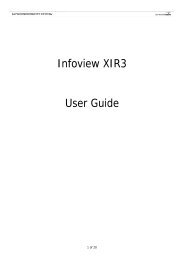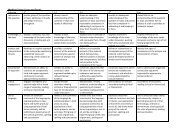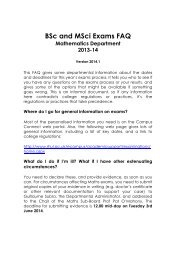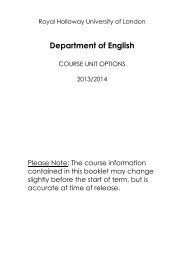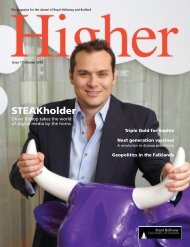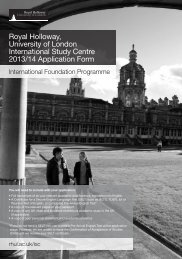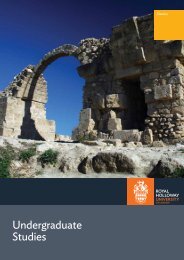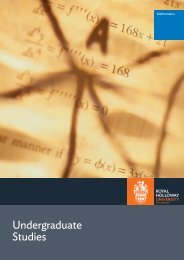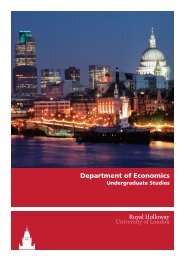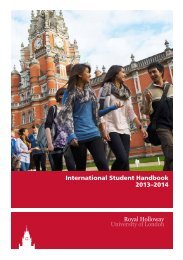Financial Statements 2011 - Royal Holloway, University of London
Financial Statements 2011 - Royal Holloway, University of London
Financial Statements 2011 - Royal Holloway, University of London
Create successful ePaper yourself
Turn your PDF publications into a flip-book with our unique Google optimized e-Paper software.
Notes to the <strong>Financial</strong> <strong>Statements</strong>(continued)USS is a “last man standing” scheme so that in the event <strong>of</strong>the insolvency <strong>of</strong> any <strong>of</strong> the participating employers in USS, theamount <strong>of</strong> any pension funding shortfall (which cannot otherwisebe recovered) in respect <strong>of</strong> that employer will be spread across theremaining participant employers and reflected in the next actuarialvaluation <strong>of</strong> the scheme.The trustee believes that over the long-term equity investmentand investment in selected alternative asset classes will providesuperior returns to other investment classes. The managementstructure and targets set are designed to give the fund a majorexposure to equities through portfolios that are diversified bothgeographically and by sector. The trustee recognises that it wouldbe theoretically possible to select investments producing incomeflows broadly similar to the estimated liability cash flows. However,in order to meet the long-term funding objective within a level <strong>of</strong>contributions that it considers the employers would be willing tomake, the trustee needs to take on a degree <strong>of</strong> investment riskrelative to the liabilities. This taking <strong>of</strong> investment risk seeks totarget a greater return than the matching assets would providewhilst maintaining a prudent approach to meeting the fund’sliabilities. Before deciding what degree <strong>of</strong> investment risk to takerelative to the liabilities, the trustee receives advice from its internalinvestment team, its investment consultant and the schemeactuary, and considers the views <strong>of</strong> the employers. The strongpositive cash flow <strong>of</strong> the scheme means that it is not necessary torealise investments to meet liabilities. The trustee believes that this,together with the ongoing flow <strong>of</strong> new entrants into the schemeand the strength <strong>of</strong> the covenant <strong>of</strong> the employers enables it totake a long-term view <strong>of</strong> its investments. Short- term volatility<strong>of</strong> returns can be tolerated and need not feed directly to thecontribution rate although the trustee is mindful <strong>of</strong> the desirability<strong>of</strong> keeping the funding level on the scheme’s technical provisionsclose to or above 100% thereby minimizing the introduction <strong>of</strong>deficit contributions. The actuary has confirmed that the scheme’scash flow is likely to remain positive for the next ten years or more.SAULThe latest triennial actuarial valuation <strong>of</strong> the scheme was at 31March 2008. The following assumptions were used to assess thepast service funding position and future service liabilities:Investment return on liabilitiesp.a. -before retirementInvestment return on liabilitiesp.a. -after retirementSalary growth p.a. excluding anallowance for increments6.9% (past service) 7.0%(future service)4.8% (past service) 5.0%(future service)4.85% (past service) 4.85%(future service)Pension increases p.a. 3.35% (past service) 3.35%(future service)The actuarial valuation applies to the scheme as a whole and doesnot identify surpluses or deficits applicable to individual employers.As a whole, the market value <strong>of</strong> the scheme’s assets was £1,266million representing 100% <strong>of</strong> the liability for benefits after allowingfor expected future increases in salaries.Based on the strength <strong>of</strong> the employer covenant and the trustee’slong-term investment strategy, the trustee and the employersagreed to maintain employer and member contributions at 13% <strong>of</strong>salaries and 6% <strong>of</strong> salaries respectively following the valuation.A comparison <strong>of</strong> SAUL’s assets and liabilities calculated usingassumptions consistent with FRS 17 revealed SAUL to be in surplusat the last formal valuation date <strong>of</strong> 31 March 2008.The next formal actuarial valuation <strong>of</strong> the scheme is due at 31March <strong>2011</strong> when the rates above will be reviewed.The pension cost for the College was £1,487k (2009/10 £1,356k),<strong>of</strong> which £457k (2009/10 £308k) related to salary sacrifice.The pension cost includes £124k (2009/10 £98k) outstandingcontributions at the balance sheet date.The next formal triennial actuarial valuation is due as at 31 March<strong>2011</strong>. The contribution rate will be reviewed as part <strong>of</strong> eachvaluation and may be reviewed more frequently.The USS pension cost for the College was £9,357k (2009/10£8,193k) <strong>of</strong> which £2,531k (2009/10 £1,635k) related to salarysacrifice. The pension cost includes £844k (2009/10 £852k)outstanding contributions at the balance sheet date. Thecontribution rate payable by the College was 16% <strong>of</strong> pensionablesalaries from 1 October 2009 and 14% up to that date.38



